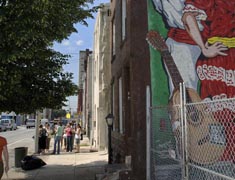Seeing with New Eyes
March 13, 2009 - GSE student teachers learn about the place their students call home
"It's the most dangerous neighborhood in Philadelphia. I went out there and I drove around. I can’t teach there."
A student in the master’s program in teacher education voiced his concern about his practicum site to the program coordinators. But they were not easily deterred.
The next year, the students walked.
 On pedestrian tours led by community members, the students took in neighborhood sights unobstructed by car mirrors or reflected bias. The objects, the streets, and the people became closer than they had initially appeared. No one wanted to go home.
On pedestrian tours led by community members, the students took in neighborhood sights unobstructed by car mirrors or reflected bias. The objects, the streets, and the people became closer than they had initially appeared. No one wanted to go home.
That tour, conducted in 2001, changed GSE’s Master’s Program in Elementary Education. Now the first "assignment" in the program, the tour serves as the touchstone for the master's curriculum. It also illuminates the innovation in the School’s teacher education program: Most schools separate social issues and methods, but GSE integrates them throughout the curriculum. In every class, our students talk about theory and practice in the same sentence.
That kind of cohesion is exactly what the teacher education faculty had in mind when they first envisioned changes to the MSEd program. In order to prepare teachers for Philadelphia's urban schools, the faculty designed a coherent program with courses that share integrated assignments.
Today, the Master's in Elementary Education is a one-year program divided into five terms, with progressively more time teaching in the classroom. The first "term" immediately sets the stage. For five mid-summer weeks, students focus on "Neighborhoods and Schools," beginning with tours of the neighborhoods where they will teach, researching their assigned schools and environments, and developing a social studies curriculum based on their findings. In the fall and spring semesters, student teachers take courses and spend substantial time in the classrooms as student teachers. Beginning with a focus on learners and learning, the program encourages the prospective teacher to develop an understanding of teaching and curriculum based on this deep knowledge of students and their communities.
Students see the benefits immediately. Says Randi Harris GEd'06, "I had a better understanding of where my students played, where they prayed, and how their community affected their daily interactions."
Roberto Lopez GEd'06 completed his practicum in North Philadelphia's McKinley School. Interested in urban education, Lopez sought to study the intersections of race, class, and education. For Lopez, the neighborhood study "contributed to helping me better understand what my purpose will be both in and out of the classroom ... and this is where it becomes more of a 'life' goal than a 'career' goal."
Starting with the neighborhood tour, GSE's teacher ed students are inspired to see "with new eyes" — eyes that look for what's positive, that look for resilience, and that look for what they can bring to the community.
Says Jackie Pallas GEd'06, "I do believe [the neighborhood study experience] changed how I viewed 'being a teacher.' The greatest part of GSE's program is how it forces us as teachers to readjust our lens to focus not only on the school where we teach, but also on the neighborhood where the school is located."
